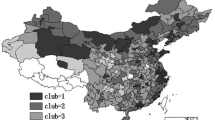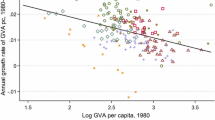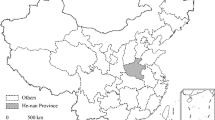Abstract
Latin America experiences an increasing urban primacy index and a rapid expansion of the financial system, putting direct pressure on the demand for resources to satisfy the consumption of large cities. We investigate the convergence of per capita biocapacity in 16 Latin America countries and evaluate the factors that influence its evolution over time. Specifically, we analyze the impact of the urban primacy index, economic progress, and the financial globalization index on the convergence of per capita biocapacity. We use the methodological framework developed by Phillips and Sul Econometrica 75:1771-1855, (2007) to analyze the convergence and the formation of convergence clubs of biocapacity during 1970–2017. The findings indicate that the countries of the region do not share a common trend of biocapacity, although they are grouped into five converging clubs. Biocapacity transition analysis reveals that countries have heterogeneous transition pathways between them. Using marginal effects, we find that the urban primacy index and economic progress reduce the biocapacity. The effect of the financial globalization index on biocapacity is not conclusive. The quantile regressions reveal that quantiles’ impact of the urban primacy index and financial globalization on per capita biocapacity is heterogeneous. However, the effect of economic progress on biocapacity that predominates among quantiles is positive. The adoption of common policies among the countries that form the converging clubs could improve the effectiveness of pro-environmental policies and promote the achievement of the Sustainable Development Goals related to environmental quality.




Similar content being viewed by others
References
Abbasi KR, Hussain K, Radulescu M, Ozturk I (2022) Asymmetric impact of renewable and non-renewable energy on the industrial sector in Pakistan: fresh evidence from Bayesian and non-linear ARDL. Renew Energy 187:944–957
Adedoyin FF, Agboola PO, Ozturk I, Bekun FV, Agboola MO (2021) Environmental consequences of economic complexities in the EU amidst a booming tourism industry: accounting for the role of Brexit and other crisis events. J Clean Prod 305:127117
Adedoyin F, Ozturk I, Abubakar I, Kumeka T, Folarin O, Bekun FV (2020) Structural breaks in CO2 emissions: are they caused by climate change protests or other factors? J Environ Manag 266:110628
Ahmed Z, Wang Z (2019) Investigating the impact of human capital on the ecological footprint in India: an empirical analysis. Environ Sci Pollut Res 26(26):26782–26796
Ahmed Z, Zafar MW, Ali S, Danish (2020) Linking urbanization, human capital, and the ecological footprint in G7 countries: an empirical analysis. Sustain Cities Soc 55:102064
Alola AA, Ozturk I, Bekun FV (2021) Is clean energy prosperity and technological innovation rapidly mitigating sustainable energy-development deficit in selected sub-Saharan Africa? A myth or reality. Energy Policy 158:112520
Alvarado R, Toledo E (2017) Environmental degradation and economic growth: evidence for a developing country. Environ Dev Sustain 19(4):1205–1218
Alvarado R, Ortiz C, Jiménez N, Ochoa-Jiménez D, Tillaguango B (2021) Ecological footprint, air quality and research and development: the role of agriculture and international trade. J Clean Prod 288:125589
Baabou W, Grunewald N, Ouellet-Plamondon C, Gressot M, Galli A (2017) The Ecological Footprint of Mediterranean cities: awareness creation and policy implications. Environ Sci Policy 69:94–104
Baloch MA, Ozturk I, Bekun FV, Khan D (2021) Modeling the dynamic linkage between financial development, energy innovation, and environmental quality: does globalization matter? Bus Strateg Environ 30(1):176–184
Bansal S, Sharma GD, Rahman MM, Yadav A, Garg I (2021) Nexus between environmental, social and economic development in South Asia: evidence from econometric models. Heliyon 7(1):e05965
Bastianoni S, Coscieme L, Caro D, Marchettini N, Pulselli FM (2019) The needs of sustainability: the overarching contribution of systems approach. Ecol Indic 100:69–73
Bekun FV (2022) Mitigating emissions in India: accounting for the role of real income, renewable energy consumption and investment in energy. Int J Energy Econ Policy 12(1):188–192
Bekun FV, Emir F, Sarkodie SA (2019) Another look at the relationship between energy consumption, carbon dioxide emissions, and economic growth in South Africa. Sci Total Environ 655:759–765
Bekun FV, Gyamfi BA, Onifade ST, Agboola MO (2021) Beyond the environmental Kuznets Curve in E7 economies: accounting for the combined impacts of institutional quality and renewables. J Clean Prod 314:127924
Bertinelli L, Strobl E, Zou B (2008) Economic development and environmental quality: a reassessment in light of nature's self-regeneration capacity. Ecol Econ 66(2-3):371–378
Bhattacharya M, Inekwe JN, Sadorsky P (2020) Consumption-based and territory-based carbon emissions intensity: determinants and forecasting using club convergence across countries. Energy Econ 86:104632
Bi M, Xie G, Yao C (2020) Ecological security assessment based on the renewable ecological footprint in the Guangdong-Hong Kong-Macao Greater Bay Area, China. Ecol Indic 116:106432
Borucke M, Moore D, Cranston G, Gracey K, Iha K, Larson J, Lazarus E, Morales JC, Wackernagel M, Galli A (2013) Accounting for demand and supply of the biosphere’s regenerative capacity: the National Footprint Accounts’ underlying methodology and framework. Ecol Indic 24:518–533
Breitung J (2001) The local power of some unit root tests for panel data. In: Nonstationary panels, panel cointegration, and dynamic panels. Emerald Group Publishing Limited
Bridges EM, Oldeman LR (2010) Global assessment of human-induced soil degradation. Arid Soil Res Rehabil 13(4):319–325
Canay IA (2011) A simple approach to quantile regression for panel data. Econ J 14(3):368–386
Chernozhukov V, Fernández-Val I, Melly B (2013) Inference on counterfactual distributions. Econometrica 81(6):2205–2268
Coscieme L, Pulselli FM, Niccolucci V, Patrizi N, Sutton PC (2016) Accounting for “land-grabbing” from a biocapacity viewpoint. Sci Total Environ 539:551–559
Coscieme L, Sutton PC, Anderson S, Liu Q, Elvidge CD (2017) Dark Times: Nighttime satellite imagery as a detector of regional disparity and the geography of conflict. GIsci Remote Sens 54(1):118–139
Damette O, Delacote P (2012) On the economic factors of deforestation: what can we learn from quantile analysis? Econ Model 29(6):2427–2434
Danish, Wang Z (2019) Investigation of the ecological footprint’s driving factors: what we learn from the experience of emerging economies. Sustain Cities Soc 49:101626
Danish, Hassan ST, Baloch MA, Mahmood N, Zhang JW (2019) Linking economic progress and ecological footprint through human capital and biocapacity. Sustain Cities Soc 47:101516
Fichter K, Tiemann I (2020) Impacts of promoting sustainable entrepreneurship in generic business plan competitions. J Clean Prod 267:122076
Franco S (2021) Assessing the environmental sustainability of local agricultural systems: how and why. Curr Res Environ Sustain 3:100028
Gabbi G, Matthias M, Patrizi N, Pulselli FM, Bastianoni S (2021) The biocapacity adjusted economic progress. Developing new indicator. Ecol Ind 122:107318
Galli A (2015) On the rationale and policy usefulness of ecological footprint accounting: the case of Morocco. Environ Sci Policy 48:210–224
Galli A, Iha K, Moreno Pires S, Mancini MS, Alves A, Zokai G, Lin D, Murthy A, Wackernagel M (2020) Assessing the Ecological Footprint and biocapacity of Portuguese cities: critical results for environmental awareness and local management. Cities 96:102442
Gao J, Tian M (2016) Analysis of over-consumption of natural resources and the ecological trade deficit in China based on ecological footprints. Ecol Indic 61:899–904
Hassan ST, Baloch MA, Mahmood N, Zhang J (2019) Linking economic growth and ecological footprint through human capital and biocapacity. Sustain Cities Soc 47:101516
He W, Chen H (2022) Will China’s provincial per capita energy consumption converge to a common level over 1990–2017? Evidence from a club convergence approach. Energy 249:123624
Holden E (2012) Ecological footprint. In: In International Encyclopedia of Housing and Home, 2nd edn. Elsevier Ltd, Amsterdam
Işık C, Ahmad M, Ongan S, Ozdemir D, Irfan M, Alvarado R (2021) Convergence analysis of the ecological footprint: theory and empirical evidence from the USMCA countries. Environ Sci Pollut Res 28(25):32648–32659
Ivanovski K, Churchill SA, Smyth R (2018) A club convergence analysis of per capita energy consumption across Australian regions and sectors. Energy Econ 76:519–531
Jiang G, Alvarado R, Murshed M, Tillaguango B, Toledo E, Méndez P, Isik C (2022) Effect of agricultural employment and export diversification index on environmental pollution: building the agenda towards sustainability. Sustainability 14(2):677
Koenker R, Bassett G Jr (1978) Regression quantiles. Econometrica: J Econ Soc 46:33–50
Mancini MS, Galli A, Niccolucci V, Lin D, Hanscom L, Wackernagel M, Bastianoni S, Marchettini N (2017) Stocks and flows of natural capital: implications for Ecological Footprint. Ecol Indic 77:123–128
Marti L, Puertas R (2020) Analysis of the efficiency of African countries through their Ecological Footprint and Biocapacity. Sci Total Environ 722:137504
Nathaniel S, Nwodo O, Sharma G, Shah M (2020) Renewable energy, urbanization, and ecological footprint linkage in CIVETS. Environ Sci Pollut Res 27(16):19616–19629
Niccolucci V, Coscieme L, Marchettini N (2021) Benefit transfer and the economic value of Biocapacity: introducing the ecosystem service Yield factor. Ecosyst Serv 48:101256
Niccolucci V, Tiezzi E, Pulselli FM, Capineri C (2012) Biocapacity vs Ecological Footprint of world regions: a geopolitical interpretation. Ecol Indic 16:23–30
Niccolucci V, Pulselli FM, Tiezzi E (2007) Strengthening the threshold hypothesis: economic and biophysical limits to growth. Ecol Econ 60(4):667–672
Pesaran MH (2007) A simple panel unit root test in the presence of cross-section dependence. J Appl Econom 22(2):265–312
Pesaran MH (2015) Testing weak cross-sectional dependence in large panels. Econom Rev 34(6–10):1089–1117
Pesaran MH, Yamagata T (2008) Testing slope homogeneity in large panels. J Econ 142(1):50–93
Pesaran MH, Schuermann T, Weiner SM (2004) Modeling regional interdependencies using a global error-correcting macroeconometric model. J Bus Econ Stat 22(2):129–162
Phillips PC, Sul D (2007) Transition modeling and econometric convergence tests. Econometrica 75(6):1771–1855
Phillips PC, Sul D (2009) Economic transition and growth. J Appl Econ 24(7):1153–1185
Ponce P, Alvarado R (2019) Air pollution, output, FDI, trade openness, and urbanization: evidence using DOLS and PDOLS cointegration techniques and causality. Environ Sci Pollut Res 26(19):19843–19858
Powell D (2022) Quantile regression with nonadditive fixed effects. Empir Econ 1–17
Rapport DJ (2000) Ecological footprints and ecosystem health: complementary approaches to a sustainable future. Ecol Econ 32(3):367–370
Rashid A, Irum A, Malik IA, Ashraf A, Rongqiong L, Liu G, Ullah H, Ali MU, Yousaf B (2018) Ecological footprint of Rawalpindi; Pakistan’s first footprint analysis from urbanization perspective. J Clean Prod 170:362–368
Raven P, Wackernagel M (2020) Maintaining biodiversity will define our long-term success. Plant Diver 42(4):211–220
Saba CS, Ngepah N (2022) Convergence in renewable energy sources and the dynamics of their determinants: an insight from a club clustering algorithm. Energy Rep 8:3483–3506
Sarkodie S (2021) Environmental performance, biocapacity, carbon & ecological footprint of nations: drivers, trends and mitigation options. Sci Total Environ 751:141912
Sauvé S, Bernard S, Sloan P (2016) Environmental sciences, sustainable development and circular economy: alternative concepts for trans-disciplinary research. Environ Dev 17:48–56
Shao J, Tillaguango B, Alvarado R, Ochoa-Moreno S, Alvarado-Espejo J (2021) Environmental impact of the shadow economy, globalisation, trade and market size: Evidence using linear and non-linear methods. Sustainability 13(12):6539
Sharif A, Baris-Tuzemen O, Uzuner G, Ozturk I, Sinha A (2020) Revisiting the role of renewable and non-renewable energy consumption on Turkey’s ecological footprint: evidence from Quantile ARDL approach. Sustain Cities Soc 57:102138
Siche R, Pereira L, Agostinho F, Ortega E (2010) Convergence of ecological footprint and emergy analysis as a sustainability indicator of countries: Peru as case study. Commun Nonlinear Sci Numer Simul 15(10):3182–3192
Świąder M, Lin D, Szewrański S, Kazak JK, Iha K, van Hoof J, Belčáková I, Altiok S (2020) The application of ecological footprint and biocapacity for environmental carrying capacity assessment: a new approach for European cities. Environ Sci Policy 105:56–74
Syrovátka M (2020) On sustainability interpretations of the Ecological Footprint. Ecol Econ 169:106543
Tillaguango B, Alvarado R, Dagar V, Murshed M, Pinzón Y, Méndez P (2021) Convergence of the ecological footprint in Latin America: the role of the productive structure. Environ Sci Pollut Res:1–13
Trinh LQ, Doan HTT (2018) Internationalization and the growth of Vietnamese micro, small, and medium sized enterprises: evidence from panel quantile regressions. J Asian Econ 55:71–83
Ulucak R, Bilgili F (2018) A reinvestigation of EKC model by ecological footprint measurement for high, middle and low income countries. J Clean Prod 188:144–157
Usman O, Alola AA, Sarkodie SA (2020) Assessment of the role of renewable energy consumption and trade policy on environmental degradation using innovation accounting: evidence from the US. Renew Energy 150:266–277
Vačkář D (2012) Ecological Footprint, environmental performance and biodiversity: a cross-national comparison. Ecol Indic 16:40–46
Wackernagel M, Hanscom L, Lin D (2017) Making the sustainable development goals consistent with sustainability. Front Energy Res 5:18
Wackernagel M, Lin D, Hanscom L, Galli A, Iha K (2018) Ecological footprint. Encycl Ecol 4:270–282
Wang H, Hu Y, Liang Y (2021) Simulation and spatiotemporal evolution analysis of biocapacity in Xilingol based on CA-Markov land simulation. Environ Sustain Ind 11:100136
Wang Y, Kang L, Wu X, Xiao Y (2013) Estimating the environmental Kuznets curve for ecological footprint at the global level: a spatial econometric approach. Ecol Indic 34:15–21
Yan H, Pan L, Xue Z, Zhen L, Bai X, Hu Y, Huang HQ (2019) Agent-based modeling of sustainable ecological consumption for grasslands: a case study of Inner Mongolia, China. Sustainability 11(8):2261
Yang Y, Fan M (2019) Analysis of the spatial-temporal differences and fairness of the regional energy ecological footprint of the Silk Road Economic Belt (China Section). J Clean Prod 215:1246–1261
Yilanci V, Pata UK (2020a) Are shocks to ecological balance permanent or temporary? Evidence from LM unit root tests. J Clean Prod 276:124294
Yilanci V, Pata UK (2020b) Convergence of per capita ecological footprint among the ASEAN-5 countries: evidence from a non-linear panel unit root test. Ecol Indic 113:106178
Zhang S, Shi Q, Cheng M (2017) Renewable natural capital, the biocapacity, and subjective well-being. J Clean Prod 150:277–286
Zhou Y, Kong Y, Wang H, Luo F (2020) The impact of population urbanization lag on eco-efficiency: a panel quantile approach. J Clean Prod 244:118664
Author information
Authors and Affiliations
Contributions
R. A.: estimates, supervision, edition, results and discussion; B. T.: statistical data, analysis; Estimates; L. C.: estimates correction, conclusions and policy implications; S. P., conceptualization, data curation; M. R. A-L.: literature review; C, I.: introduction, preliminary analysis of results. V. D. editing, conclusions.
Corresponding author
Ethics declarations
Competing interests
The authors declare no competing interests.
Additional information
Responsible Editor: Ilhan Ozturk
Publisher’s note
Springer Nature remains neutral with regard to jurisdictional claims in published maps and institutional affiliations.
Rights and permissions
About this article
Cite this article
Alvarado, R., Tillaguango, B., Cuesta, L. et al. Biocapacity convergence clubs in Latin America: an analysis of their determining factors using quantile regressions. Environ Sci Pollut Res 29, 66605–66621 (2022). https://doi.org/10.1007/s11356-022-20567-6
Received:
Accepted:
Published:
Issue Date:
DOI: https://doi.org/10.1007/s11356-022-20567-6




